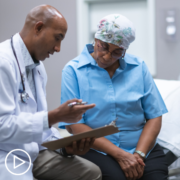How Can We Advance Equitable Access to Precision Medicine in Lung Cancer Care?
How Can We Advance Equitable Access to Precision Medicine in Lung Cancer Care? from Patient Empowerment Network on Vimeo.
With non-small cell lung cancer (NSCLC) precision medicine, what are disparities and strategies to equitable access? Expert Dr. Samuel Cykert from UNC School of Medicine discusses disparities, strategies to overcome disparities, and proactive patient advice toward optimal care.
[ACT]IVATION TIP
“…I know you do electronic health records, and as soon as this visit is done, you have data about my visit, so have you thought about creating a real-time registry to see how I’m progressing with my care and see how others are progressing with their care, whether to make sure that we don’t have missed appointments and to make sure that I’m not falling behind where I should be.”
Download Resource Guide | Descargar guía de recursos
See More from [ACT]IVATED Non-Small Cell Lung Cancer
Related Resources:

|

Improving Biomarker Testing Access for Rural Lung Cancer Patients |

Empowering Lung Cancer Patients | Embracing Hope, Treatment, and Teamwork |
Transcript:
Lisa Hatfield:
Dr. Cykert, are there any disparities in access to biomarker testing for Black and Latinx patients with lung cancer compared to other racial or ethnic groups, and if so, what strategies or initiatives can be implemented to address these disparities and promote equitable access to precision medicine?
Dr. Samuel Cykert:
Yeah, biomarker testing followed up by precision medicine is really fairly new in the last half-dozen years, so there haven’t been a lot of studies done looking at how well we’re doing in different groups, but there’s a journal called The Journal of Clinical Oncology and precision medicine that published such a study in 2022.
And what that showed…and again, keep in mind that in a lot of…as they do in a lot of database studies, they are a couple of years behind, but what they showed in looking at the cases of over 20,000 patients, is that on first time testing, we talked about initial biopsies, when the initial biopsy is tested, there is actually about a 7 percent difference between Black and white patients with the white number being only 37 percent and the Black number being 30 percent, so that was low all the way around.
And then if you look at any biomolecular testing at any stage of the cancer, those numbers change to around 55 percent for white patients and 44 percent for Black patients, and I want to point out that for Asian patients and Latinx patients, the numbers were also low, but there weren’t enough patients in the database to achieve statistical significance, but it looks like things are going in the wrong direction there too, and when you think about it, in the state of the right now, those numbers ought to be close to 100 percent for everybody, at least in some of the basic markers like ALK and EGFR and PD-L1.
So there’s a lot of work to do. So there is a disparity. It has been documented, but we’re not getting perfect care to even anyone, and in the ACCURE (Accountability for Cancer Care through Undoing Racism and Equity) Study that I had described a little bit earlier, where we did an intervention, we created real-time transparency through up-to-date electronic health records and digital data of where patients were in their care, we were able to create a real-time registry to know what had been done for every patient, and in the case of precision medicine, this would be so easy, because you basically put every patient that’s had a lung cancer biopsy in the registry, then you have another column in the registry tested for X, tested for Y, tested for Z, and then you have a next column that says, treated for X, treated for Y, and treated for Z. We have the digital information now to do all this in real time, and we have to build the systems to do it.
Lisa Hatfield:
Could you share any examples of successful initiatives or programs aimed at improving the implementation of biomarker testing in lung cancer and what factors contribute to the success of these initiatives, and how can they be replicated or scaled in other healthcare settings?
Dr. Samuel Cykert:
I’ll have to plead my ignorance on this question because I haven’t talked to enough cancer centers on whether or not they’re creating real-time registries for whether all their patients with probable lung cancer are, [a] getting biopsied promptly, [b] getting biomarker testing, and then following those patients over time to see if they’re getting the treatments to match to that, so I know that at my own institution at the University of North Carolina Lineberger Cancer Center, we’re actively talking about building these systems, but we haven’t built them yet.
And so going back to the work that our UNC team has done in partnership with Greensboro Health Disparities Collaborative, we’ve done an intervention with real-time transparency in lung cancer treatment and breast cancer treatment, and real-time quality improvement and audit and feedback for accountability in those treatments and using navigation, particularly for high risk patients to make sure that they’re able to follow through with their diagnosis and treatment.
So with that combination in lung cancer, we got almost perfect care, 96 percent and 95 percent completing treatment, so there’s no reason that the same system cannot be applied to biomarker testing and biologic and immunotherapy, and we need to look at it and implement it and apply it as soon as possible, because when you think about all this, and I’m not just talking about cancer, but when you’re thinking about the whole picture, when you look at, for instance, Black, white disparities, whether it’s in cardiovascular care, whether it’s in diabetes, whether it’s in cancer care, if you look at the result of that in one year, if we brought up care to benchmark levels of the Black community on all those things, we would save 74,000 lives a year.
That’s incredibly impactful. And we need to quicken up the pace of doing this. I’ve been a disparities researcher and intervention researcher for over 20 years, and people really haven’t taken note of really doing interventions until the last five or six years. We need to pay attention, we need to move. It’s important. People’s lives depend on it. And care improved for everyone with these systems, it improved for white patients too. It’s not a zero-sum game.
Lisa Hatfield:
I’m wondering, as a patient, is there anything that I can do or that a patient can do to request or to ask if they use real-time data, that institution to help with the treatment or help with testing or whatever, is there a question the patient might be able to ask to ensure the real-time data is used? Because I imagine it’s not being used as often, so it could be, like you said, there probably isn’t a system in place.
Dr. Samuel Cykert:
Here’s my double activation tip. So at an institution, you don’t know if you have a problem until you look. So the first problem is, as I go back and look behind, am I making sure whether or not I’m seeing disparities, whether it’s a man, woman, Black, white, Latinx, do we have disparities in our treatment application and treatment outcomes in our institution? Because if we look at that, we can start brainstorming on how to possibly fix it, and then the second thing is, I know you do electronic health records, and as soon as this visit is done, you have data about my visit, so have you thought about creating a real-time registry to see how I’m progressing with my care and see how others are progressing with their care, whether to make sure that we don’t have missed appointments and to make sure that I’m not falling behind where I should be.
Lisa Hatfield:
Great, that’s perfect, thank you. Having the patients be…have that accountability too, to ask the question, if that exists, that real-time data, if there’s a way to use that. So thank you, I appreciate that myself personally, so thanks.
Share Your Feedback
Create your own user feedback survey



